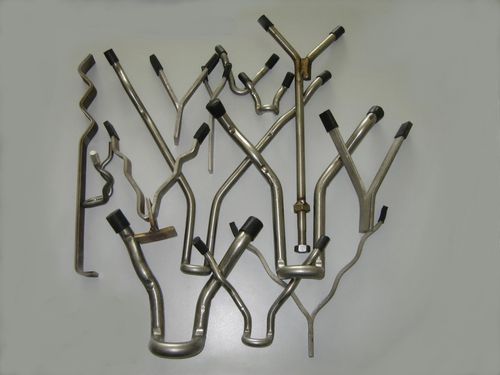Stainless Steel 316 anchor
316 Refractory Anchor, Refractory grapple for SS module materials must be synthetically and physically stable at high temperatures. Contingent upon the working environment, they should be impervious to warm stock, be synthetically dormant, and/or have particular scopes of warm conductivity and of the coefficient of warm extension.
SS 316 refectory anchors are having attractive features like- High tensile strength, Stress corrosion cracking/pitting/corrosion/oxidation/crevice corrosion resistance, Anti-corrosive, Sturdiness, Commendable dimensional accuracy
Refractory fibre & anchor systems are manufactured for all types of monolithic, ceramic fibre and brick refractory linings confirming that the exact grade of material, dimensions, spacing patterns and welding methods are selected for an anchorage system which is very necessary for retaining the refractory material and ensures the lining performance
With the help of modern technology and equipment complying with product quality standards, SS 316 V ANCHORS supplied in the market is of stunning quality. A good industry is putting all efforts in bringing out the good quality of the product so that all applications demands can be very well satisfied.
Refractory anchors have the following features- Great tensile strength, Excellent stability at high temperatures, Reliable performance, Precise designing, Durability, Sturdy construction, Hardness.
Chemical Composition of Stainless Steel 316 Anchors
| Grade 316 | Ni | Cr | C | Mn | P | S | Si | Mo | Fe |
|---|---|---|---|---|---|---|---|---|---|
| min. | 19.0 | 24.0 | - | - | - | - | - | - | 53.095 |
| max. | 21.0 | 26.0 | 0.08 | 2.00 | 0.045 | 0.30 | 1.00 | 0.75 | - |
Mechanical Properties of Stainless Steel 316 Anchors
| Grade | Tensile Strength (MPa) min | Yield Strength 0.2% Proof (MPa) min | Elongation (% in 50mm) min | Hardness | |
|---|---|---|---|---|---|
| Rockwell B (HR B) max | Brinell (HB) max | ||||
| 316 | 75 (515) | 30 (205) | 35 | 90 | 198 |
| 316H also has a requirement for a grain size of ASTM No 7 or coarser. | |||||
Physical Properties of Stainless Steel 316 Anchors
| Density (kg/m3) | Elastic Modulus (GPa) | Mean Coefficient of Thermal Expansion (m/m/0C) | Thermal Conductivity (W/m.K) | Specific Heat 0-1000C (J/kg.K) | Electrical Resistivity (n.m) | |||
|---|---|---|---|---|---|---|---|---|
| 0-1000C | 0-3150C | 0-5380C | at 1000C | at 5000C | ||||
| 8000 | 200 | 16 | - | 500 | 16 | 16 | 500 | 25 |
Grade Specification for Stainless Steel 316 Anchors
| Grade | UNS No | Old British | Euronorm | Swedish SS | Japanese JIS | ||||||||||||||||||
|---|---|---|---|---|---|---|---|---|---|---|---|---|---|---|---|---|---|---|---|---|---|---|---|
| BS | En | No | Name | ||||||||||||||||||||
| 316 | S31600 | 1.4401 | - | - | X10CrNi18-8 | - | - | ||||||||||||||||
|
These comparisons are approximate only. The list is intended as a comparison of functionally similar materials not as a schedule of contractual equivalents. If exact equivalents are needed original specifications must be consulted. Stainlees Steel At Elevated TemperaturesStandard Stainless Steels provide conosion resistance in a number of aggressive situations. They also provide very good oxidation and scaling resistance at elevated temperatures. In situations where standard steels reach their temperature limits, higher alloy and specially designed stainless steels provide a combination of increased strength and oxidation resistance,extending the useful working range up to higher temperatures around 1200°C.
|
|||||||||||||||||||||||
